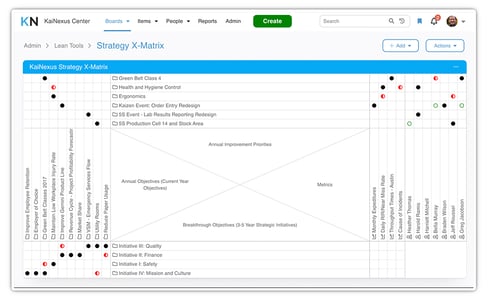 Lean Strategy Deployment, also known as Hoshin Kanri, is a systematic approach organizations use to align their annual objectives around strategy with the day-to-day activities of their teams. It originated from the Toyota Production System and has been widely adopted in various industries.
Lean Strategy Deployment, also known as Hoshin Kanri, is a systematic approach organizations use to align their annual objectives around strategy with the day-to-day activities of their teams. It originated from the Toyota Production System and has been widely adopted in various industries.
The main goal of Lean Strategy Deployment is to ensure that every level of the organization is working towards achieving the same breakthrough objectives, strategic goals, and corporate priorities. The leadership team can track progress and initiate course corrections where needed.
Organizations use Strategy Deployment to create a culture of continuous improvement, collaboration, and accountability. It fosters a holistic and systematic approach to achieving excellence. The method is essential in today's hyper-competitive and highly transparent business environment.
This article will cover some key concepts behind the Lean improvement methodology, introduce the Lean strategy development framework, cover the tools commonly used during Lean planning, and walk through Strategy Deployment step-by-step.
Understanding the Basics of Lean Thinking
What is Lean? At its core, Lean thinking is a management philosophy and principles that focus on creating value for customers while minimizing waste. It has been applied in various industries and organizations worldwide. The foundational principles of Lean include:
Customer Value: Lean thinking places the utmost importance on understanding and delivering what customers truly value. It involves identifying customer needs, preferences, and expectations to provide products or services that meet or exceed those requirements.
Value Stream: A value stream is the sequence of activities that create value for the customer. Lean thinking emphasizes mapping and analyzing the entire value stream to identify and eliminate non-value-added activities (waste) and streamline the flow of value-added activities.
Flow: A primary goal of Lean is to establish a smooth and uninterrupted flow of work, materials, and information throughout the value stream. Organizations can improve efficiency, reduce lead times, and enhance customer satisfaction by minimizing interruptions, bottlenecks, and delays.
Pull System: Instead of producing goods or providing services based on a forecast or push from the upstream processes, Lean promotes a pull system. This means that products or services are made or delivered in response to actual customer demand.
Continuous Improvement: Continuous improvement, or Kaizen, involves empowering employees at all levels to identify and implement minor, incremental improvements in their work processes regularly.
Respect for People: Lean thinking recognizes that people are the most valuable asset in any organization. It emphasizes creating a supportive and respectful work environment that promotes collaboration, teamwork, and the development of employees' skills and capabilities.
Standardization: Lean promotes establishing standard work processes and procedures that define the most effective and efficient way to perform tasks. Standardization ensures consistency, reduces errors, and provides a baseline for continuous improvement efforts.
Waste Reduction: Lean identifies eight types of waste, also known as "Muda," which include overproduction, waiting, transportation, overprocessing, excess inventory, motion, defects, and underutilized skills. Lean thinking aims to eliminate or minimize these wastes to optimize processes and resource utilization.
Lean principles were initially developed in manufacturing, particularly in the automotive industry. Today, it is used in healthcare to improve patient flow and streamline administrative tasks. Lean principles have found application in the construction industry to improve project management and construction processes. Agile methodologies such as Scrum and Kanban draw inspiration from Lean principles to enhance productivity and responsiveness in software development teams. Virtually every industry has found a useful application for Lean thinking.
What is the difference between policy deployment and strategy deployment?
Policy Deployment and Strategy Deployment are terms often used interchangeably, but they can have slightly different meanings depending on the context.
Policy Deployment is a management process that aligns the organization's policies, objectives, and actions throughout the hierarchy. It ensures that everyone in the organization works towards a common set of objectives. Strategy Deployment is a process that aims to align the organization's strategic goals and initiatives with the day-to-day activities of teams and individuals. It bridges the gap between the strategic planning process and operational execution.
Policy Deployment often operates within a longer time horizon, typically covering multiple years. It involves the development of long-term policies and objectives that guide the organization's activities over an extended period. Strategy Deployment operates within a shorter time frame, usually one year or less. It involves translating strategic goals into actionable initiatives and action plans for the current or upcoming operational period.
While the terms Policy Deployment and Strategy Deployment may have nuanced differences, it's important to note that different organizations and industries may use them interchangeably or adapt them to their specific contexts. Ultimately, both processes aim to create alignment, improve performance, and achieve the organization's objectives.
The Evolution of Lean Strategy Deployment
Introduction to Hoshin Kanri
Hoshin Kanri, or Policy Deployment, is a strategic planning and management system that originated in Japan. The history of Hoshin Kanri can be traced back to the 1950s and 1960s, when it was developed and practiced by several Japanese companies, most notably Toyota.
The roots of Hoshin Kanri can be attributed to the teachings and philosophies of Dr. W. Edwards Deming, an American statistician and quality management expert. In the 1950s, Deming introduced his ideas on Total Quality Management (TQM) to Japanese industries, emphasizing the importance of systematic planning, continuous improvement, and the involvement of all employees.
In the context of Hoshin Kanri, "True North" refers to the ultimate goal or direction an organization strives to achieve. It represents the ideal state or destination that guides the organization's actions, decisions, and strategies. True North serves as a compass, providing a clear and unwavering focus for the organization's efforts.
Over time, Hoshin Kanri gained recognition as a robust strategic management methodology within the automotive industry and in various sectors worldwide. Its success at Toyota and other Japanese companies contributed to its global adoption as a best practice in strategic planning and execution.
What sets Lean Strategy Deployment apart from traditional strategic planning is its bottom-up approach, in which strategies are developed collaboratively throughout the organization, involving input from all levels. Conventional methods may suffer from a gap between strategic planning and execution. The focus is primarily on creating a plan, and implementation can be fragmented or disconnected from the overall strategy. With Lean, conversely, continuous improvement principles are integrated into the strategy deployment process, allowing for refinement and adjustments based on feedback and results.
Lean Strategy Deployment Frameworks
In addition to Hoshin Kanri, several other structured policy deployment approaches are popular.
Toyota Production System (TPS)
The Toyota Production System is an integrated set of manufacturing principles, practices, and philosophies developed by the Japanese automaker Toyota. It is renowned for its effectiveness in improving efficiency, quality, and overall performance in manufacturing operations. The TPS, also known as Lean Manufacturing or Just-in-Time production, has had a profound influence on the field of operations management.
Lean Enterprise Model
The Lean Enterprise model expands beyond manufacturing and encompasses the entire organization. It extends Lean principles to various functions and processes, including product development, supply chain management, customer service, and administrative activities. It seeks to understand customer needs, align processes to meet them, and deliver a superior customer experience across all touchpoints. The Lean Enterprise model requires a broad cultural transformation across the entire organization.
Agile Strategy Management
Agile Strategy Management is an approach to strategic planning and execution that combines the principles of agile methodologies with strategic management practices. It enables organizations to be more flexible, adaptive, and responsive in a rapidly changing business environment. Agile Strategy Management connects strategy formulation and execution by promoting iterative, collaborative, and customer-centric practices.
Lean Strategy Deployment Tools and Techniques
Value Stream Mapping
Value Stream Mapping is a visual representation of the end-to-end process that a product or service goes through, from raw materials to the customer. It helps identify non-value-added activities, bottlenecks, and opportunities for improvement initiatives in the process flow.
A3 Problem-Solving Process
The A3 problem-solving process is a structured approach used to solve problems and make improvements within organizations. It derives its name from the size of the paper (A3) traditionally used to document the problem-solving process. The A3 process is a vital component of the Toyota Production System. It promotes collaborative problem-solving, critical thinking, and the development of effective countermeasures.
Gemba Walks
Gemba is a Japanese term that means "the real place" or "the actual place." Gemba walks involve going to the location where work is happening, whether it's a shop floor, office, or any other operational area, to observe and engage with employees and processes directly. The primary purpose of Gemba walks is for team leaders to gain firsthand knowledge, understand the current state of operations, identify opportunities for improvement, and foster a culture of continuous improvement.
Kaizen Events
Kaizen events, also known as Kaizen blitz or rapid improvement events, are focused, short-term initiatives that bring together a cross-functional team to identify and implement improvements in a specific process or area within an organization. Kaizen events attempt to achieve significant and immediate improvements quickly, typically lasting a few days to a week.
X-Matrix
It is common for organizations utilizing a formal Hoshin planning methodology to use a visualization tool called an "X-Matrix" to develop, explain, and help implement tactical and strategic plans. The tool helps with cross-functional coordination and breaks down silos. The process of creating the X-matrix can be used to develop the strategy itself. Most leaders have a good idea of what the breakthrough goals ought to be, but the process of filling in the other sections of the tool can be very revealing. A well-thought-out X-matrix requires the involvement of multiple stakeholders, giving lots of people the opportunity to help determine how the team will navigate toward True North.

PDCA (Plan-Do-Check-Act) Cycle
The PDCA cycle, also known as the Deming cycle or the Plan-Do-Check-Act cycle, is a four-step iterative problem-solving and continuous improvement methodology. It was developed by Dr. W. Edwards Deming, a renowned quality management expert.
The steps are:
Plan: Define the problem or goal, analyze the current state, and establish targets.
Do: Implement the plan and document observations.
Check: Measure results, and identify variances and root causes.
Act: Take corrective actions, standardize, institutionalize, and plan for the next cycle.
Six Sigma Methodology
The Six Sigma methodology is a data-driven approach and quality management framework aiming to improve processes, minimize defects, and reduce variation in operational and business processes. It was developed by Motorola in the 1980s and later popularized by companies like General Electric. The term "six sigma" refers to a statistical measure of process performance, indicating a high level of process capability and the ability to produce products or services with minimal defects.
Steps to Implement Lean Strategy Deployment
Assessing the current state of the organization
To assess its current state, an organization can use various methods and tools to comprehensively understand its performance, strengths, weaknesses, and areas for improvement. This is the first step of Lean strategy deployment.
Defining strategic objectives and initiatives
The organization then defines its long-term goals, vision, and mission. These objectives should be specific, measurable, achievable, relevant, and time-bound (SMART).
Establishing key performance indicators (KPIs) and targets
Key Performance Indicators (KPIs) are the measurable metrics that will be used to evaluate progress toward achieving the strategic objectives and operational targets. KPIs provide quantifiable performance measures, allowing organizations to track their performance, identify areas of improvement, and make informed decisions.
Cascading goals through the organization
The strategic objectives are cascaded down throughout the organization, ensuring alignment at every level. This involves breaking the high-level goals into specific objectives for each department or team.
Developing action plans and allocating resources
Once the initiatives are selected, leadership works with middle management to develop tactics to execute them effectively. This includes identifying responsible individuals or teams, setting targets, and establishing timelines.
Implementing and monitoring progress
Progress is regularly tracked and monitored against the established targets and key performance indicators. This helps identify any deviations or obstacles and allows for timely adjustments and corrective actions.
Continuous improvement and learning from feedback
The Lean philosophy of continuous improvement is integrated into the strategy deployment process. Lessons learned, and feedback from the implementation phase are used to refine and improve future cycles.
Conclusion
Implementing Lean strategy deployment is a proactive approach to strategic management that enables organizations to navigate complex business environments, improve performance, and achieve long-term goals. It provides a structured framework for aligning strategies, engaging employees, delivering customer value, and continuously improving the organization's capabilities. By embracing Lean deployment, your organization can enhance competitiveness, adapt to change, and drive sustainable growth.

![[WEBINAR] Strategy Deployment Software Demo](https://no-cache.hubspot.com/cta/default/326641/67b72769-975a-48b1-b5d8-4ba0fe1f3b76.png)


Add a Comment